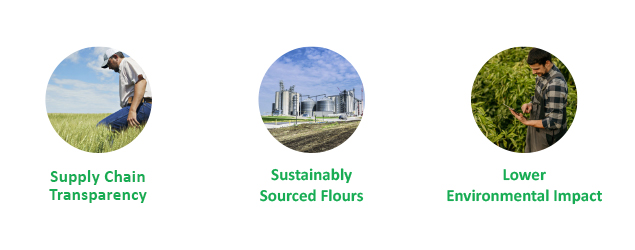Sustainable sourcing has become an important topic for businesses. Companies need to meet the growing expectations of stakeholders, including investors, retailers, employees, and consumers, when it comes to sustainable practices. Thus, companies are increasingly incorporating sustainability criteria into their procurement and supply chain management process to manage risks while tapping into opportunities.
This article discusses the definition and criteria of sustainable sourcing, challenges, and benefits, as well as the steps a company can take to implement such practices into the purchasing process.
Defining a Movement
Sustainable sourcing is the process of selecting suppliers based on environmental, social, and governance (ESG) criteria and performance factors throughout the supply chain. Examples from each sustainability pillar include:
- Environmental: Greenhouse gas emissions, air pollution, waste, water quality, natural resource utilization, regenerative agriculture
- Social: Diversity, equity, & inclusion, health & safety, resource access, labor rights, accessibility/affordability
- Governance: Policies & procedures, such as supplier code of conduct, no-deforestation policy, environmental policy, human rights policy, and routine disclosures & communications
 Source: ADM
Source: ADMWhy Sustainable Sourcing
In recent years, sustainable sourcing has become a key investment space in the food and beverage industry. According to a 2021 industry survey1, 69% of executives surveyed said they had planned sustainable sourcing investments vs 58% the year prior.
Aside from helping to achieve your organization's social and environmental impact goals, there are many benefits to investing in sustainable sourcing, including:
- Reduced costs: A sustainable sourcing program can help identify risks in your supply chain and mitigate costs.
- Improved financial performance: Business studies (e.g. ESG and Financial Performance, NYU & RAM, 2020) have shown that companies investing in ESG and sustainable practices outperform those that do not.
- Enhanced Reputation: Brands can leverage ESG and sustainability efforts to build positive associations with consumers, future and current employees, partners, and investors.
- Better Relationships: Companies can build stronger, long-term relationships with suppliers by working together on sustainability challenges and opportunities.
- Legal Compliance: New and emerging regulations will increasingly require businesses to identify and address impacts that their operations and supply chains have on ESG-related issues.
Looking at the bigger picture regarding the benefits of investing in sustainable sourcing is essential. Stakeholders across the supply chain demand that their partners and suppliers have policies and programs for sustainable practices. Proactively developing a sustainable sourcing strategy can differentiate your organization and broaden appeal with customers and industry partners.
Developing a Path to More Sustainable Sourcing
How do you get started developing a sustainable sourcing strategy? First, it may help to begin with an internal assessment. Define what sustainability means to your company and customers and what in-house programs can be implemented, e.g., reducing energy and water usage, greenhouse gas emissions, and food waste or using recyclable packaging. Once internal programs are established, sustainable sourcing strategies can enhance these efforts. Companies can start the sustainable sourcing process through a variety of actions: by identifying U.N. sustainable development goals relevant to your company via the SDG impact assessment tool, mapping your supply chain, conducting supplier assessments, and identifying opportunities for collaboration and improvement.
Many organizations establish policies for their sustainable business programs. For example, companies can develop a supplier code of conduct to communicate your expectations to your suppliers, particularly before a new relationship begins.
Finally, it is essential that your sustainability improvement efforts are documented and regularly reported to build a positive reputation with employees, suppliers, investors, and customers.
Sustainable sourcing can be complex. It requires a holistic view of all the partners, processes, logistics, and raw materials involved in manufacturing and delivering your products to customers. It also requires tracking, collecting, and connecting data at each step.
However, sustainable sourcing isn't just about risks and challenges. It also presents opportunities to protect the environment, reduce costs, produce differentiated goods, and elevate your company's brand.
Sustainable Sourcing Opportunities
Some tangible actions an organization can take to achieve sustainable sourcing goals include:
- Completing a materiality assessment/human rights saliency exercise to identify key risks and opportunities within the supply chain
- Procuring energy-efficient technologies and services
- Purchasing and sourcing waste or byproduct streams as raw material inputs (upcycling)
- Sourcing raw materials with sustainable certifications (RSPO, ISCC, Fair Trade)
- Sourcing a greater percentage of recycled and upcycled raw materials for products and packaging
- Sourcing your ingredients from growers implementing regenerative agriculture practices
- Collaborating with supply chain partners to identify resource needs and support global sustainability goals (U.N. Sustainable Development Goals)
Your sustainable sourcing strategy should fit the needs and realities of your business, but at a minimum, consider ESG factors and key supplier relationships.
Why ADM
Sustainable sourcing is not just a buzzword; it's a fundamental shift in how forward-thinking organizations operate. Integrating sustainable sourcing practices into procurement processes not only represents a responsible choice but can also be strategic. By understanding the complexities of sustainable sourcing, navigating challenges, and embracing the benefits, your company can contribute to a more resilient food supply chain with opportunities to secure a competitive edge in the market.
 Source: ADM and ©
LAFAMILGA - STOCK.ADOBE.COM
Source: ADM and ©
LAFAMILGA - STOCK.ADOBE.COM Achieving your organization's sustainable sourcing and climate goals can be challenging, especially with Scope 3 emissions making up a large portion of your environmental footprint. One potential key to reaching your long-term environmental impact goals? Regenerative agriculture practices that enable Scope 3 emissions reductions and removals. At ADM, through our re:generations™ program and sustainably-sourced flour options, we work together with growers to identify and implement regenerative farming practices that can:
- Reduce GHG emissions
- Sequester carbon
- Protect water quality
- Improve soil health
- Advance farm resiliency
- Increase supply reliability
Partner with ADM to advance your sustainable sourcing and environmental impact goals for a better tomorrow.






